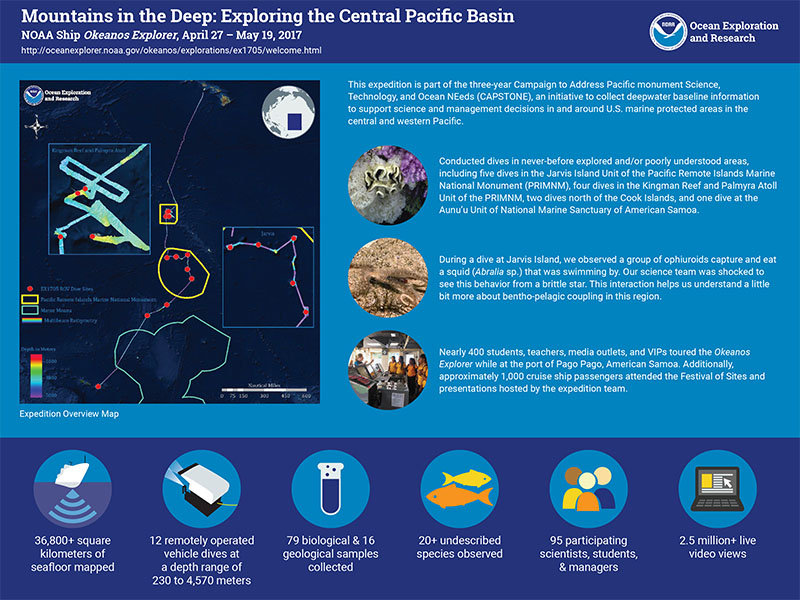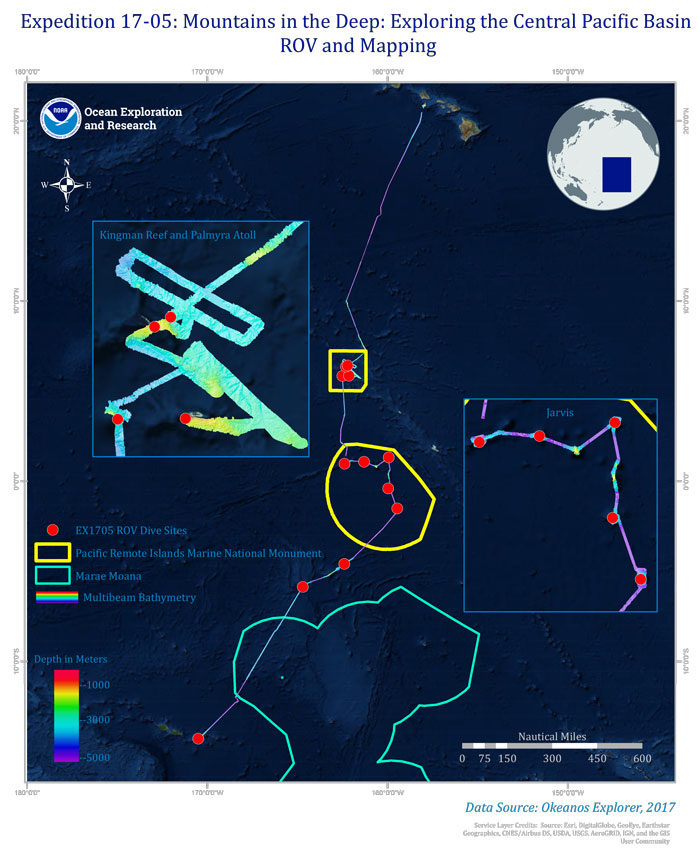
April 27 – May 19, 2017

Infographic summarizing accomplishments from the Mountains in the Deep: Exploring the Central Pacific Basin expedition. Image courtesy of the NOAA Office of Ocean Exploration and Research, Mountains in the Deep: Exploring the Central Pacific Basin. Download (pdf, 1.5 MB).
This expedition is part of the three-year Campaign to Address Pacific monument Science, Technology, and Ocean NEeds (CAPSTONE), an initiative to collect deepwater baseline information to support science and management decisions in and around U.S. marine protected areas in the central and western Pacific.

Overview map showing seafloor bathymetry collected and ROV dives conducted during the Mountains in the Deep: Exploring the Central Pacific Basin expedition. Image courtesy of the NOAA Office of Ocean Exploration and Research, Mountains in the Deep: Exploring the Central Pacific Basin. Download image (jpg, 130 KB).
The Mountains in the Deep: Exploring the Central Pacific Basin expedition was a 23-day telepresence-enabled expedition to collect critical baseline information about unknown and poorly known deepwater areas of the Jarvis Island Unit and the Kingman Reef and Palmyra Atoll Unit of the Pacific Remote Islands Marine National Monument (PRIMNM), now known as Pacific Islands Heritage Marine National Monument; around Marae Moana (Cook Islands Marine Park); and the high seas. The goal of the expedition was to use remotely operated vehicle (ROV) dives and seafloor mapping operations to increase the understanding of the deep-sea ecosystems in these areas to support management decisions. Major accomplishments from this expedition are summarized below. Download a PDF version of this summary. (pdf, 3.8 MB)
The Pacific Remote Islands Marine National Monument, now known as Pacific Islands Heritage Marine National Monument, was founded in 2009. The Monument was expanded in 2014 to include protection of Jarvis Island, which is about 1,000 miles south of Hawaii. Prior to the Mountains in the Deep expedition, very little seafloor mapping had been done in the area and no ROV dives had ever been conducted; however, over the course of the expedition, scientists mapped the area with high-resolution multibeam and conducted five ROV dives. The dives offered the first-ever glimpses at the deepwater habitats around Jarvis and were described by members of the science party as being ‘amazing.’ Beyond the ‘wow factor,’ data collected during the expedition will help establish baseline information about the geology and biology in the area, providing the foundation for better management moving forward. Video courtesy of the NOAA Office of Ocean Exploration and Research, Mountains in the Deep: Exploring the Central Pacific Basin. Download larger version (mp4, 38.8 MB).
Conducted 12 ROV dives ranging in depth from 230 to 4,570 meters to learn more about remote areas of the central Pacific Basic. Operations focused on characterizing the morphology and geologic history of seafloor features and surveying midwater and benthic habitats. As the ship moved from the southern to the northern hemisphere, ROV dives explored precious coral and bottomfish habitats; abyssal communities in a deep fracture zone; and manganese-encrusted and carbonate seafloor habitats at seamounts, atolls, and islands.
On May 6, after finishing exploration of the seafloor, we conducted a series of midwater transects from 1,400 to 300 meters (~4,595 to 985 feet). These transects increase our knowledge about the largest, yet one of the least understood, biomes on Earth. The dive took place in the Jarvis Unit of the Pacific Remote Islands Marine National Monument, now known as Pacific Islands Heritage Marine National Monument, which is one of the few units of the monument where the water column is protected in addition to the seafloor. Video courtesy of the NOAA Office of Ocean Exploration and Research, Mountains in the Deep: Exploring the Central Pacific Basin. Download larger version (mp4, 24.9 MB).
Mapped more than 36,800 square kilometers of seafloor, an area larger than the state of Maryland.
Investigated a variety of different geological features including seamounts, atolls, ridges, and plateaus.
One of the primary goals of the Mountains in the Deep expedition was to get a good first look at the deep-sea habitats that exist throughout the Central Pacific Basin, with a particular focus on seamounts. During the expedition, the team was able to combine high-resolution multibeam mapping data with ROV dives to give us an entirely new understanding of these mountains that rise from the deep and serve important roles in the overall ocean ecosystem. Video courtesy of the NOAA Office of Ocean Exploration and Research, Mountains in the Deep: Exploring the Central Pacific Basin. Download larger version (mp4, 130.6 MB).
Collected more than 7.2 TB of data, including multibeam, single beam, subbottom, ADCP, XBT, CTD and dissolved oxygen profiles, surface oceanographic and meteorological sensors, video, imagery, and associated dive and video products. All of the data from this expedition will be made publically available through national archives.
Engaged with audiences around the world, opening a window to the deep sea in some of the planet’s most remote locations.